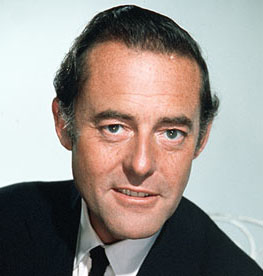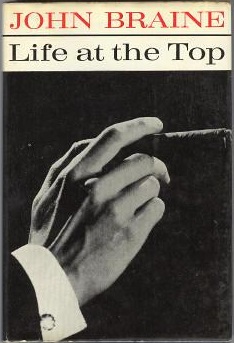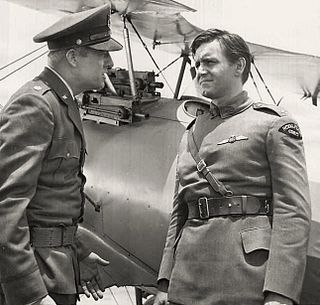
Simone Signoret was a French actress. She received various accolades, including an Academy Award, three BAFTA Awards, a César Award, a Primetime Emmy Award, and the Cannes Film Festival Award for Best Actress, in addition to nominations for two Golden Globe Awards.

Laurence Harvey was a Lithuanian-born British actor and film director. He was born to Lithuanian Jewish parents and emigrated to South Africa at an early age, before later settling in the United Kingdom after World War II. In a career that spanned a quarter of a century, Harvey appeared in stage, film and television productions primarily in the United Kingdom and the United States.

John Gerard Braine was an English novelist. Braine is usually listed among the angry young men, a loosely defined group of English writers who emerged on the literary scene in the 1950s.

Hermione Youlanda Ruby Clinton-Baddeley was an English actress of theatre, film and television. She typically played brash, vulgar characters, often referred to as "brassy" or "blowsy". She found her milieu in revue, in which she played from the 1930s to the 1950s, co-starring several times with the English actress Hermione Gingold.

Samuel John Kydd was a British actor. His best-known roles were in two major British television series of the 1960s, as the smuggler Orlando O'Connor in Crane and its sequel Orlando. He also played a recurring character in Coronation Street. Kydd's first film was The Captive Heart (1946), in which he played a POW. He made over 290 films, more than any other British actor, including 119 between 1946 and 1952.
Jack Isaac Clayton was a British film director and producer who specialised in bringing literary works to the screen.
Sir John Woolf and his brother James Woolf were British film producers. John and James founded the production companies Romulus Films and Remus Films, which were active during the 1950s and 1960s, and the distribution company Independent Film Distributors, which was active 1950–59 and handled the UK distribution of films such as The African Queen and Gift Horse, as well as several films made by their two production companies.

Terence Joseph Alexander was an English film and television actor, best known for his role as Charlie Hungerford in the British TV drama Bergerac, which ran for nine series on BBC1 between 1981 and 1991.

Room at the Top is a novel by John Braine, first published in the United Kingdom by Eyre & Spottiswoode in 1957, about an ambitious young working-class man who juggles sexual relationships with two middle-class women in a northern town in post-war England.

Life At The Top is the third novel by the English author John Braine, first published in the UK by Eyre & Spottiswoode and in the US by Houghton Mifflin & Co. in 1962. It continues the story of the life and difficulties of Joe Lampton, an ambitious young man of humble origins. A 1965 film adaptation of the novel was made starring Laurence Harvey.

Heather Christine Sears was a British stage and screen actress.

Kenneth William Michael Haigh was an English actor. He first came to public recognition for playing the role of Jimmy Porter in the play Look Back in Anger in 1956 opposite Mary Ure in London's West End theatre. Haigh's performance in the role on stage was critically acclaimed as a prototype dramatic working-class anti-hero in post-Second World War English drama.
James Edmund Neil Paterson was a Scottish writer of novels, short stories and screenplays. He won the 1959 Academy Award for Best Adapted Screenplay for Room at the Top. Before his success as a writer, he worked in journalism and had a brief career as an amateur footballer, playing for Buckie Thistle, Leith Athletic and Dundee United in the Scottish Football League.

Life at the Top is a 1965 British drama film, a production of Romulus Films released by Columbia Pictures. The screenplay was by Mordecai Richler, based on the 1962 novel Life at the Top by John Braine, and is a sequel to the film Room at the Top (1959). It was directed by Ted Kotcheff and produced by James Woolf, with William Kirby as associate producer. The music score was by Richard Addinsell and the cinematography by Oswald Morris. The film's art director, Edward Marshall, received a 1966 BAFTA Award nomination.

Sydney Tafler was an English actor who after having started his career on stage, was best remembered for numerous appearances in films and television from the 1940s to the 1970s.

John McIntosh Beattie, known professionally as John Warwick, was an Australian actor and television dramatist.
The 12th British Academy Film Awards, given by the British Academy of Film and Television Arts in 1959, honoured the best films of 1958.

Man at the Top is a 1973 British drama film directed by Mike Vardy and starring Kenneth Haigh, spun off from the television series Man at the Top, which itself was inspired by the 1959 film Room at the Top and its 1965 sequel Life at the Top.

Man at the Top was a British kitchen sink drama television series that originally aired on ITV, lasting for 23 episodes between 1970 and 1972. The series depicted the character of Joe Lampton, the protagonist of John Braine's novels Room at the Top (1957) and Life at the Top (1962), and of the films based on those novels. In 1973, a spin-off film from the series, Man at the Top, was released.
Room at the Top is a 2012 BBC television adaptation by Amanda Coe of John Braine's 1957 novel of the same name, with a cast led by Matthew McNulty, Maxine Peake and Jenna Coleman, and directed by Aisling Walsh.














